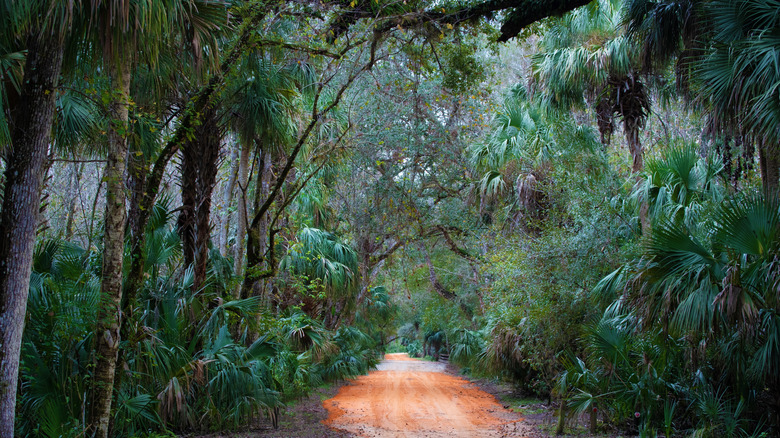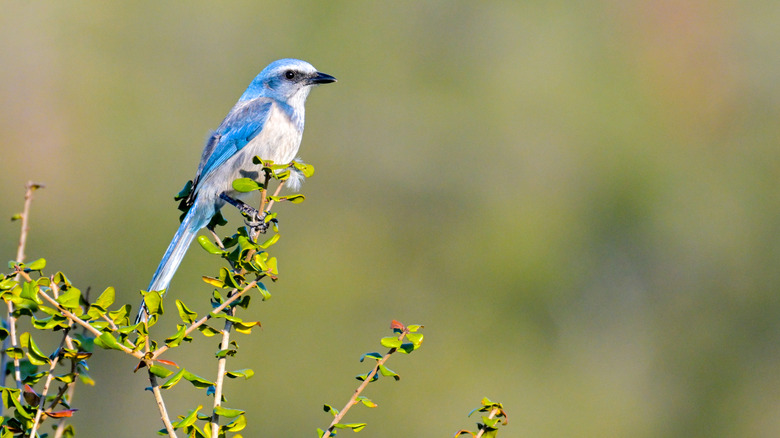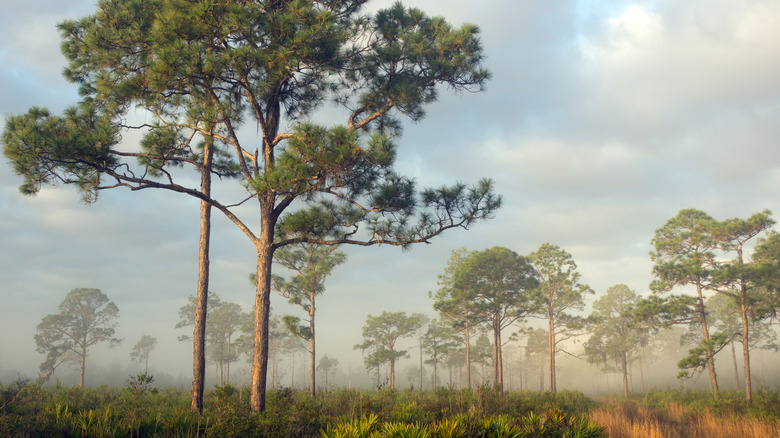Florida's Delicate State Park Is An Underrated Gem With The Most Endemic Species In The State
A nature walk in Central Florida can feel like taking a stroll through Jurassic Park. Narrow trails wind through thickets of hydric foliage and ferns, dappled with the shade of centuries-old oaks and ancient cypress trees draped in Spanish moss. The air, thick with humidity, hums with cicadas and the dull hammering of red-headed woodpeckers. An alligator slips beneath the swamp's surface, where tangled, moss-covered hammocks of trees loom up from the sandy soil. This is the heartbeat of Florida, also known as Highlands Hammocks State Park. Located just 75 miles east of Sarasota, it's one of Florida's oldest state parks and is renowned for its endemic biodiversity.
With nearly 200 state parks, Florida boasts diverse landscapes, from beachy, beautiful Bahia Honda State Park in the Florida Keys, where you can snorkel and camp right on the coast, to Caverns State Park, a unique, underrated, and underground Florida park. But Highlands Hammocks is particularly special, featuring a 9,000-acre tract of protected land full of old-growth cypress and ancient oaks, as well as a plethora of rare flora and fauna, like the elusive Florida panther and black bears. Additionally, deer, squirrels, turtles, alligators, and a variety of bird species all thrive in this multi-habitat expanse.
A "hammock" is a dense stand of hardwood trees, elevated a few inches off the ground and typically found in wet ecosystems. Live oak, mahogany, and red maple are examples of hammock-forming trees, and they're found all over the park. Trails, boardwalks, a historic conservation museum, and alligator tram tours constitute plenty of reasons to make this your next Florida destination. Just fly into Sarasota-Bradenton International Airport (SRQ) and drive 74 miles east via FL-64 E. Alternatively, you can fly into Orlando International Airport (MCO), about 90 miles north via US-27 S.
Highlands Hammock has many trails and an alligator tram
Florida is home to some of the best nature trails, from peaceful boardwalks to jungle hikes. Highlands Hammock State Park features both types as well as a range of old and new forest growth along nine trails and a Scenic Loop Drive, a pleasant 5-mile jaunt you can bike or drive along. Alexander Blair Big Oak Trail, a short, easy trail less than 1,000 feet long, is the gateway to the park where you'll see the 36-foot-diameter trunk of a live oak, the oldest and largest tree in the park. The Ancient Hammock Trail loops into the Fern Garden Trail, another boardwalk/flat terrain path that takes you through the marsh without soaking your feet. Meanwhile, the Young Hammock Trail explores newer groves and the long stages of forest renewal. If you want a longer stroll, a 2.5-mile loop combines the Wild Orange Grove, Hickory Trail, and Fern Garden Loop.
A few of the park's trails — including the popular Hickory and Cypress Swamp Trails — are closed for renovation as of this writing, so the best way to spot "modern dinosaurs" is via the Alligator Tram Tour, a fully accessible service that typically runs through fall, winter, and spring (Central Florida outdoors in the summer is only for the bravest of bodies!). You'll need to buy tickets day-of at the Hammock Inn Camp Store, found in the park's "picnic loop."
While Highlands Hammock is open year-round, the tram doesn't run in the summer. The best time of year to go is October through April to beat both the humidity and the bugs. Regardless, wear sturdy shoes, sunscreen, and bug spray, as mosquitoes and sunshine are two of Florida's biggest specialties!
Highlands Hammock prioritizes nature conservation and balancing its delicate ecosystems
The habitats in Highlands Hammock balance a delicate tapestry of ecosystems, some of which are designated, meaning they're at risk. As part of the Great Florida Birding and Wildlife Trail, you can spot endemic scrub jays as well as a range of songbirds, raptors, and migratory birds, plus there's an ADA-accessible observation deck. Other endemic species to be on the lookout for are gopher tortoises and two species of air plants.
Highlands Hammock State Park is one of eight parks built by President Roosevelt's "New Deal" employment programs in the 1930s. During the Great Depression, thousands of young Americans were employed by the federal government to build parks, restore forests, and plant trees. Today, the park houses the Civilian Conservation Corps (CCC) Museum, which educates visitors on the park's history through interactive exhibits, activities, docent-led tours, and even a scavenger hunt for children. Admission to the museum is free with park entrance, the price of which varies.
As of this writing, the campground at Highlands Hammock is closed for renovations. In the meantime, consider staying at the privately owned Lake Placid Campground, located 27 miles south of the park on Lake Placid, or at Whispering Pines Village, an RV and mobile home park in nearby Sebring. If you're willing to trek a bit further, turn your trip into a two-for-one adventure; Kissimmee Prairie Preserve, about 50 miles east of Sebring, is one of the closest alternative state parks. In addition to numerous trails and prime birding, it offers campsites and safari tent-style glamping options that are perfect for stargazing, thanks to the park's renowned lack of light pollution. Another great option is Lake Kissimmee State Park, a "one-stop shop" for outdoors enthusiasts, with camping, hiking, wildlife, and boating all found about 48 miles north of Sebring.


